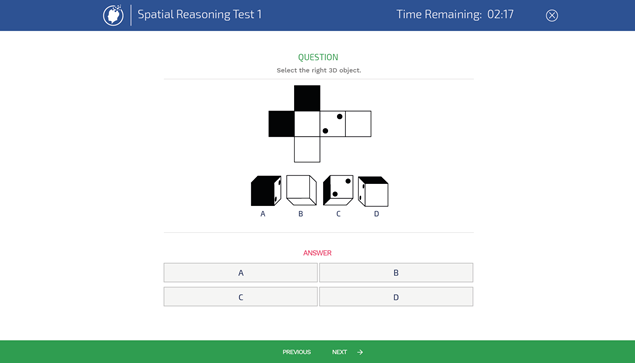- 197 Tests
- 3146 Questions
- One-off payment
Tips to pass a Spatial Reasoning test

What is a Spatial Reasoning Test?
Spatial reasoning tests may be chosen by some employers as a part of psychometric tests to assess your ability to visualize and manipulate two-dimensional and three-dimensional figures. They may involve assembling and disassembling objects and images in a way that you would be expected to rotate them or view them from different angles or assess the kind of markings they have on their surfaces.
Example of a spatial reasoning test:
These tests are typically given to candidates who have applied for job roles that involve technical or design-related activities. Such jobs usually include architecture, surveying jobs, design, engineering, astronomy, economic forecasting, etc. Apart from these job sectors, a spatial reasoning test may also be given to candidates applying for positions that relate to parts of sciences where 3-dimensional figures are analyzed and assessed. Apart from the above positions, these tests may also be helpful in different military job positions since these tests usually depend on mental mapping and manipulations of objects, and envisaging their movements before reaching a decision.
Spatial reasoning tests usually contain tricky questions to confuse candidates. Below useful information is set out to help you perform well on your spatial reasoning test:
What Does a Spatial Reasoning Test Evaluate?
Spatial reasoning tests are usually a common method of assessing the abilities of candidates who applied for a job position involved in the sectors mentioned before. These may be useful to the recruiting company to be aware of a candidate’s mental capacity to arrange, rearrange, design, manipulate and rotate various objects with different varieties of shapes without physically touching them.
These tests may help the recruiters realize how you will try to solve problems that might arise in a normal work routine. In the case of designers, the results of these spatial reasoning tests come in very handy; as these educate the recruiters in analyzing how the potential designers would calculate and measure dimensions of various artwork requirements when necessary.
- First Step – Analyze the Building Blocks
The best approach to attempting abstract reasoning questions is to be systematic and methodical rather than relying on random guessing. For this reason, you should carefully assess the building blocks provided to you in the question. This can be done by looking at the below-mentioned features as an example:
- Number of sides of the objects
- Elements are drawn inside the object
- Colour of the objects
- Second Step – Look for Patterns and Rules
In this step, you should carefully consider the patterns followed in the designs of these objects. If you see something getting reduced, you should look for this pattern through the sequence. On the contrary, if you find multiplication of numbers or objects, identify how the multiplication has been done and if that rule remains the same through the given sequence. The rules may also be based on colours, so look for anything that has a constant yet uniform change. It may also be a change in the number of sides in the sequence. Therefore, a thorough look at the entire series of objects is imperative in this regard.
- Third Step – Disqualifying
This is the step when you will materialize your thinking and think that you have begun applying your reasons and justifications. You should start disqualifying the options that you think don’t add up as per the above steps. This will help you in filtering the options and reducing the number of choices to eventually reach the correct answer.
How to Succeed in Spatial Reasoning Tests?
The above steps may help you to ace your spatial reasoning test. However, there are a few important things that you should consider before taking the test for optimum results. The most important step is practice because these tests usually contain technical questions that may require you to invest time and think about the given answers with proper reasoning and justifications. Practice will help you get familiar with the question format and perform under time pressure, allowing you to perform well during the actual spatial reasoning test.
These tests are usually conducted online, but sometimes also in paper form, depending on the preference of the employer. If possible, you should inquire from your recruiter how they will be taking the test beforehand.
As with all other tests, before starting the test you should carefully read the given instructions. You should pay heed to any kind of special instruction or guidance given to you that may help you accelerate your answering speed. As said earlier, time is of the essence in spatial reasoning tests. Due to the nature of the test where you are required to visualize objects, you may end up spending a lot of time per question. By practising you will see that you will get better at recognizing patterns and will work more efficiently through the questions. Practice will also give you more confidence since you will know what to expect and are familiar with the question format.
Finally, when taking the test, make sure you are prepared with a working sheet or rough piece of paper and a pencil. You will normally be given this to make rough workings. Sometimes you can be asked to hand these in with the test, but usually, they do not form part of the assessment.
How can Assessment-Training.com help you ace your Spatial Reasoning test?
Assessment-Training.com is your number 1 online practise aptitude test and assessment provider. We aim to help you ace your assessment by providing you with practise aptitude tests that mimic the tests used by employers and recruiters. Our test developers have years of experience in the field of occupational psychology and developed the most realistic and accurate practice tests available online. Our practise platform uses leading-edge technology and provides you feedback on your scores in form of test history, progress and performance to your norm group.
Check out our tailor-made Spatial Reasoning Test Pack to fully prepare you for your assessment.
The Assessment-Training.com data science team found that candidates increased their scoring accuracy through practice and went into their assessments more confident. Remember, you need to practice to make sure you familiarize yourself with the test formats, work on your accuracy and experience performing under time pressure.
Spatial Reasoning
- 8 Tests
- 64 Questions
- One-off payment
- 197 Tests
- 3146 Questions
- One-off payment
Spatial Reasoning
- 8 Tests
- 64 Questions
- One-off payment
